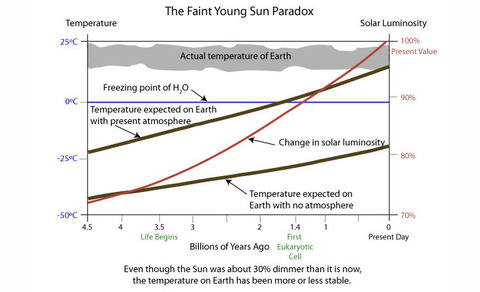As the Sun gets older and older Earth gets hotter and hotter because the Sun becomes more luminous. If humans were able to go back in time they will find that the Sun will get fainter resulting in a much colder Earth. Imagine Earth, a huge ice ball rotating through space, many scientists believe that is how things were.
The Faint Young Sun paradox describes the contradiction between observations of liquid water being found in the Earth’s early history and the expectation that the Sun’s output would be only 70% as intense during that era as it is today. The reduction in the amount of light radiated by the Sun resulted in a loss of heat felt on the Earth, which was not enough for life to flourish. Any liquid exposed to the Earth’s cold surface would freeze, but that could not have been the case because geological records show existence of liquid water in rocks over 4 billion years ago! This conundrum still puzzles leading scientists. The only possible solutions are if greenhouse gases on Earth were higher in the past than they are now, or if the Earth had a much thicker atmosphere. Read on for more information!
The x-axis on the graph below is the Earth’s age; beginning at 4.5 billion years ago and ending today. The y- axis on this graph (left) is the temperature on Earth, and the y-axis (right) is the solar luminosity. You can see that as you go back in the time the Sun was less bright; the red line represents this. The blue horizontal line represents the freezing point of H2O on Earth (which is 0 degrees Celsius). The brown lines predict Earth’s temperature based on its current atmosphere (top brown line) and Earth’s temperature without any atmosphere (bottom brown line). Notice how as the solar luminosity increases so do the temperature on Earth with/ without an atmosphere. As seen on the graph the brown lines are below freezing for several billion years in Earth’s early history. However, geologists concluded that the temperature on Earth was always warm enough to host life because rocks show unique signatures of water and heat exposure , the grey area shows the measured temperature using these rocks’ signatures (geologists rock at this type of work!). So the data presented (grey area) doesn’t match the predictions made by scientists (brown lines). How is this possible?
Possible solutions to this paradox are that Earth had either better greenhouses gases or a thicker atmosphere in the past, which both could have drastically increased Earth’s temperature. Greenhouse gases are gases in the atmosphere that absorb radiation within the thermal infrared range (heat). One can think of greenhouse gases like a blanket, one’s body heat (Earth’s heat from the Sun) gets trapped in the blanket (atmosphere) and does not escape. But some blankets do a better job at warming than others, right? Greenhouse gases work the same way! Both Carbon dioxide and methane are great examples. It takes more CO2 to warm the Earth than it takes methane. Using 10 cotton blankets (CO2) will be the same as using one fleece one (methane)! So Earth could have had a thicker atmosphere (10 blankets) or just one full of better greenhouse gases like methane (fleece).
If Earth had a thicker atmosphere or better greenhouse gases in the past, geologists have predicted that it could have been within the shaded range of temperatures. The Sun is growing larger and brighter today, but was once faint and young. How did liquid water possibly exist on a cold planet? Earth having a thicker atmosphere could be a possible solution, however, scientists don’t know what happened to the thick atmosphere to get the thinner atmosphere that we have today. No one will ever know what happened… unless we develop a time machine and go back in time, which could be cool.

